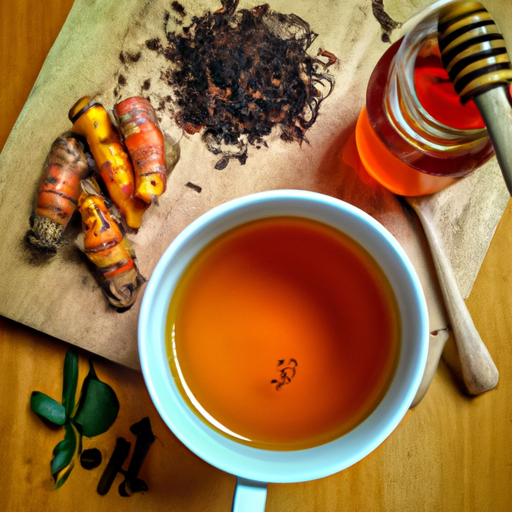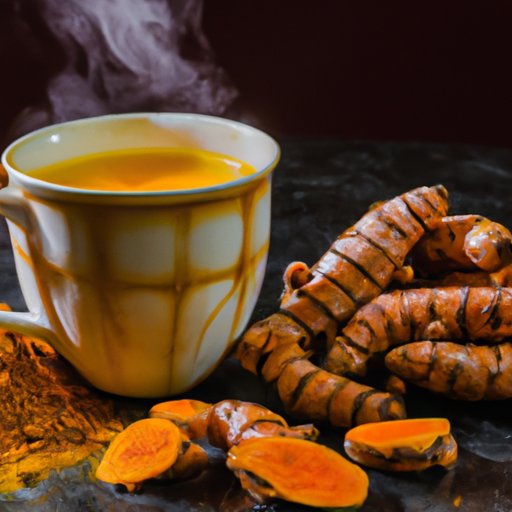Are you tired, bloated, or in need of an energy boost? Look to turmeric, a vibrant yellow spice known for its anti-inflammatory properties and numerous health benefits. Turmeric has become a popular ingredient in teas, lattes, and smoothies.
But with so many recipes and methods out there, it can be overwhelming to know the best way to make turmeric tea.
Fear not, as we have researched and tested various methods to bring you the ultimate guide on how to make the perfect cup of turmeric tea. From choosing the right turmeric to brewing tips, we’ve got you covered.
So, grab your favorite mug and let’s dive into the world of turmeric tea.
Key Takeaways
- Choose fresh, organic turmeric with vibrant color and no blemishes or spots
- The basic recipe involves boiling water with grated or powdered turmeric and simmering for 10 minutes
- Experiment with different teas and herbs like ginger, cinnamon, or cardamom to enhance the flavor
- Ideal ratio is 1 teaspoon of turmeric powder to 2 cups of water, and can be paired with honey, ginger, cinnamon, or other flavors to balance the taste
Benefits of Turmeric Tea
Turmeric tea is a delicious and healthy way to start your day, as it can provide numerous health benefits. One of the most significant benefits of turmeric tea is its anti-inflammatory properties. Turmeric contains curcumin, which has been shown to reduce inflammation and help alleviate symptoms of conditions such as arthritis, asthma, and irritable bowel syndrome.
Another benefit of turmeric tea is its ability to boost your immune system. Turmeric has antioxidant properties that help protect your cells from damage and improve your body’s ability to fight off infections.
When it comes to dosage recommendations, it’s generally recommended to consume 1-2 teaspoons of ground turmeric per day. However, it’s important to note that high doses of turmeric can have adverse effects, so it’s best to consult with a healthcare professional before increasing your intake.
Choosing the right turmeric is also essential for making the perfect cup of turmeric tea.
Choosing the Right Turmeric
Opting for the right kind of turmeric can significantly enhance the flavor profile of your homemade infusion. There are several turmeric varieties available in the market, and each has its unique flavor and aroma.
When buying turmeric, look for the ones that are fresh, have a vibrant color, and are free from any blemishes or spots. Turmeric sourcing is also an essential factor to consider. Choose turmeric that has been grown organically and hasn’t been treated with any harmful chemicals.
There are several online stores that sell high-quality turmeric powder, or you can also find them in your local grocery store. Once you’ve sourced the right kind of turmeric, you’re ready to make your basic turmeric tea recipe.
Basic Turmeric Tea Recipe
Now, let’s get started on brewing a simple, yet delicious, cup of this golden elixir. Turmeric tea is a great way to incorporate the many health benefits of this spice into your daily routine. Here’s a basic recipe to get you started:
- Boil 2 cups of water in a pot.
- Add 1 teaspoon of freshly grated or powdered turmeric.
- Let it simmer for 10 minutes.
- Strain the tea into a cup.
- Add honey, lemon, or milk to taste.
There are many variations to this recipe, depending on your preference. Some people add ginger, cinnamon, or black pepper for added flavor and health benefits. Others use coconut milk instead of regular milk for a creamier texture. Experiment with different combinations until you find your perfect cup of turmeric tea.
In addition to its delicious taste, turmeric tea also offers a range of health benefits, including reducing inflammation, boosting immunity, and improving brain function. So, grab a cup and enjoy the many benefits of this golden elixir.
In the next section, we’ll delve into the traditional Indian turmeric tea recipe.
Traditional Indian Turmeric Tea Recipe
If you’re looking to make traditional Indian turmeric tea, you’ll need to gather a few key ingredients. This recipe typically includes turmeric, ginger, black pepper, and milk.
Once you have your ingredients, you can follow a simple preparation process to make the perfect cup of turmeric tea. To enjoy this tea to its fullest potential, consider serving it with a touch of honey or a squeeze of lemon.
Ingredients
Turmeric tea is made with just a few simple ingredients, including turmeric powder, black pepper, honey, and your choice of milk. These ingredients not only make a delicious tea, but they also offer numerous health benefits.
Turmeric is known for its anti-inflammatory properties, making it a popular choice for those with joint pain or arthritis. Black pepper helps to increase the absorption of curcumin, the active ingredient in turmeric, while honey adds a touch of sweetness and also has its own health benefits, including antibacterial and antioxidant properties. Finally, adding milk to your turmeric tea can help to improve the absorption of curcumin even further.
When making turmeric tea, it is important to note that there are alternative ingredients you can use depending on your taste preferences or dietary restrictions. For example, if you’re vegan or lactose intolerant, you can use almond milk or coconut milk instead of traditional cow’s milk. Additionally, some may choose to add ginger or cinnamon to their turmeric tea for added flavor and health benefits.
Now that you know the ingredients needed for a delicious and healthy cup of turmeric tea, it’s time to move on to the preparation.
Preparation
To prepare a perfect cup of this golden-hued beverage, start by adding a teaspoon of turmeric powder and a pinch of black pepper to a small saucepan. Next, add a cup of water and bring it to a boil. Reduce the heat to low and let it simmer for 10 minutes, stirring occasionally. You can also add other ingredients like ginger, honey, or lemon to enhance the flavor and health benefits of your turmeric tea.
There are different types of turmeric tea, including turmeric chai, turmeric latte, and iced turmeric tea. Each type requires a different brewing technique, so make sure to follow the recipe instructions carefully.
Once your turmeric tea is ready, strain it into a cup and serve it hot. You can also chill it in the refrigerator and serve it over ice for a refreshing summer drink. Turmeric tea is a delicious and healthy beverage that can be enjoyed at any time of the day.
In the next section, we’ll explore some serving suggestions that can complement the flavor profile of your turmeric tea.
Serving Suggestions
Now that you’ve brewed your turmeric tea, why not pair it with some healthy snacks like apple slices with almond butter or a handful of nuts for a satisfying and nutritious midday break? Tea pairing is an art that can make your tea time even more enjoyable.
To complement the earthy and slightly spicy flavor of turmeric tea, you can serve it with a slice of lemon or lime, a teaspoon of honey, or a sprig of fresh mint. You can also experiment with different teas and herbs, such as ginger, cinnamon, or cardamom, to create your unique blend of flavors.
Presentation ideas can also make your turmeric tea more visually appealing. You can serve it in a clear glass mug or teapot to showcase its vibrant yellow color. You can also add some sliced ginger, cinnamon sticks, or dried orange peels to the tea for an extra touch of texture and flavor. Whatever presentation you choose, remember to savor your tea slowly, taking in its aroma, taste, and health benefits.
As you transition into the subsequent section about ‘ginger and turmeric tea recipe’, you can consider adding some grated ginger to your turmeric tea for a more intense and warming flavor. Ginger and turmeric are both anti-inflammatory and antioxidant-rich spices that can boost your immune system and digestion.
So, let’s explore how to combine these two powerful ingredients in a delicious and easy-to-make tea recipe.
Ginger and Turmeric Tea Recipe
First, you’ll need to grab some fresh ginger and a few teaspoons of ground turmeric to make this delicious ginger and turmeric tea recipe. Both turmeric and ginger have numerous health benefits, including anti-inflammatory and antioxidant properties. Turmeric is also known to improve brain function, while ginger can aid in digestion and reduce nausea.
To start, peel and grate a 1-inch piece of fresh ginger and add it to a pot of boiling water. Let it simmer for about 10 minutes, then add 2 teaspoons of ground turmeric and let it steep for another 5 minutes. Strain the mixture and add honey or lemon to taste. You can also experiment with adding other spices like cinnamon or black pepper for added flavor.
Now that you’ve made this delicious ginger and turmeric tea, let’s move on to the next section and learn how to make a turmeric latte recipe.
Turmeric Latte Recipe
You might be thinking that a latte made with turmeric sounds strange, but trust us, it’s worth trying. Turmeric lattes, also known as golden milk, have become increasingly popular due to their rich, creamy texture and numerous health benefits.
To make a turmeric latte, you’ll need turmeric milk, which can be made by combining turmeric powder or fresh turmeric root with milk. Simply warm up your milk of choice (dairy or non-dairy) in a saucepan and add in a teaspoon of turmeric powder or grated fresh turmeric root. You can also add other spices like cinnamon, ginger, or cardamom for added flavor and health benefits.
Once the mixture is heated through, strain it through a fine-mesh sieve to remove any lumps or chunks of turmeric root. From there, you can enjoy your turmeric milk as is or use it as a base for a turmeric latte.
Now, you might be wondering about the different variations of turmeric lattes. Some people prefer to add honey or maple syrup for sweetness, while others opt for a more savory flavor by adding black pepper or a pinch of sea salt. You can also experiment with different types of milk, such as almond milk or coconut milk, to find the perfect combination for your taste buds.
But if you’re not in the mood for a latte, don’t worry – we’ll explore other ways to enjoy turmeric in your tea next.
Turmeric Tea Bags vs Loose Turmeric
When it comes to making turmeric tea, you have two main options: using turmeric tea bags or loose turmeric powder.
Each option has its own pros and cons, and it’s important to understand them before deciding which one to use.
In this discussion, we’ll explore the benefits and drawbacks of each option, as well as provide guidance on how to use them effectively.
Pros and Cons
Unfortunately, there are both advantages and disadvantages to making turmeric tea.
On one hand, using turmeric tea bags is convenient and easy to prepare. The tea bags are pre-measured and can be steeped in hot water for a few minutes, making it a quick option for those who are always on-the-go. Additionally, some turmeric tea bags come with added ingredients, such as ginger or black pepper, which can enhance the health benefits of the tea.
However, using loose turmeric has its own set of advantages. Loose turmeric allows for more control over the strength and flavor of the tea. You can adjust the amount of turmeric to your liking and experiment with different flavor combinations. Additionally, loose turmeric is often fresher and more potent than pre-packaged tea bags.
On the downside, loose turmeric can be messier to prepare and may require additional ingredients to enhance its flavor.
When it comes to making turmeric tea, whether you choose to use tea bags or loose turmeric ultimately depends on your personal preferences and lifestyle. Now that you know the pros and cons of each option, let’s move on to the next section and discuss how to use turmeric to make the perfect cup of tea.
How to Use
First things first, let’s talk about the proper usage of this golden spice in your tea. Turmeric is a versatile ingredient that can be used in cooking and other ways to incorporate it into your diet. When using turmeric in tea, it’s important to remember that a little goes a long way. Too much of this potent spice can overpower the other flavors in your tea and leave a bitter taste.
Here are a few tips for using turmeric in your tea:
- Start with a small amount: Begin by adding just a pinch or two of turmeric to your tea and adjust the amount as needed.
- Pair it with other flavors: Turmeric has a slightly bitter taste, so it pairs well with sweet and spicy flavors like honey, ginger, and cinnamon.
- Experiment with different types of tea: Turmeric can be added to any type of tea, from black to green to herbal. Try different combinations to find the perfect flavor for you.
Now that you know how to use turmeric in your tea, let’s move on to the next important step: brewing the perfect cup.
Tips for Brewing the Perfect Cup of Turmeric Tea
To brew the perfect cup of turmeric tea, you’ll need to pay attention to three key factors: water temperature, steeping time, and ratios.
First, make sure to heat your water to the optimal temperature of 195-205°F.
Then, steep your turmeric tea for 8-10 minutes to allow the flavors to fully develop.
Finally, use a ratio of 1 teaspoon of turmeric to 1 cup of water for a well-balanced flavor.
By following these tips, you’ll be able to enjoy a delicious and healthy cup of turmeric tea every time.
Water Temperature
For the perfect cup of turmeric tea, you’ll want to start by heating your water to 195-205°F, which is just below boiling point and has been shown to extract the most beneficial compounds from the turmeric.
Boiling water can destroy some of the herbal infusions, including turmeric, and result in a bitter taste.
By keeping the water below boiling point, you’ll get a smooth and flavorful cup of tea that’s full of health benefits.
Did you know that studies have found turmeric to have anti-inflammatory and antioxidant properties? These benefits are due to the presence of curcumin, the active compound in turmeric.
By using the right temperature of water, you can ensure that you’re getting the most out of this powerful spice.
Now that you have the water temperature down, let’s move on to the next step – steeping time.
Steeping Time
Now that you’ve got the water temperature just right, let’s talk about how long you’ll want to steep your turmeric tea to get the most out of its health benefits and delicious flavor.
The recommended steeping time for turmeric tea is about 10-15 minutes. However, you can adjust the steeping time depending on your preference. If you like a stronger flavor, you can steep it for a longer period, and if you prefer a milder taste, shorten the steeping time.
Keep in mind that the steeping time also impacts the health benefits of turmeric tea. The longer you steep it, the more beneficial compounds are released, such as curcumin, which has anti-inflammatory properties. Therefore, if you’re drinking turmeric tea for health reasons, it’s best to steep it for at least 10 minutes.
Adjusting steeping time not only impacts the health benefits but also affects the flavor, so find the right balance that suits your taste buds.
As you can see, steeping time is a crucial factor to consider when making turmeric tea.
Now, let’s move on to the next section and talk about the ratio of turmeric and other ingredients in the tea.
Ratios
You may be wondering what ratios of ingredients are needed to create a well-balanced and flavorful cup of turmeric tea. The ideal ratio for making turmeric tea is 1 teaspoon of turmeric powder to 2 cups of water. This ratio ensures that the tea has a strong turmeric flavor without being overpowering.
In addition to its delicious taste, turmeric tea also boasts many health benefits. The active ingredient in turmeric, curcumin, has anti-inflammatory properties and may even help reduce the risk of certain chronic diseases. So, not only is turmeric tea a tasty beverage, but it can also be an important part of a healthy lifestyle.
Now, let’s talk about how to store and use leftover turmeric so that you can make the most of this amazing spice.
Storing and Using Leftover Turmeric
Properly storing and utilizing any leftover turmeric can enhance the flavor and health benefits of your next cup of turmeric tea. Preserving freshness is key to maximizing the potency of turmeric, which is known to degrade quickly when exposed to light, heat, and moisture. To keep your turmeric fresh, store it in a cool, dry place, away from direct sunlight. You can also extend its shelf life by storing it in an airtight container or resealable bag.
Creative uses of leftover turmeric include adding it to smoothies, soups, and stews for an added boost of flavor and nutrition. You can also mix it with honey or coconut oil to create a DIY face mask or toothpaste. Another way to use leftover turmeric is to infuse it in oil or vinegar for a homemade salad dressing or marinade. By incorporating these tips into your routine, you can make the most of your turmeric and enjoy its health benefits long after your first cup of tea.
| Storage Tips | Uses for Leftover Turmeric | |||
|---|---|---|---|---|
| Store in a cool, dry place | Add to smoothies, soups, and stews | |||
| Keep away from direct sunlight | Mix with honey or coconut oil for DIY skincare | |||
| Use an airtight container or resealable bag | Infuse in oil or vinegar for homemade dressings and marinades | Do not consume if moldy or expired | Sprinkle on top of salads or roasted vegetables for added flavor and nutrition. |
Frequently Asked Questions
Can turmeric tea help with weight loss?
Looking to shed a few pounds? Sip on some turmeric tea! Studies show it can boost metabolism and aid in weight loss. Incorporate this healthy beverage into your daily routine for a tasty and effective way to slim down.
Is it safe to consume turmeric tea during pregnancy?
Is turmeric tea safe during pregnancy? While there is limited research, it’s best to consult with a healthcare provider before consuming. Turmeric tea benefits for skin may be worth trying, but caution is advised.
Can turmeric tea help with arthritis pain?
To potentially alleviate arthritis pain, research suggests taking 500-2000mg of turmeric extract daily. However, it’s important to consult with a healthcare professional before starting any new supplement.
How much turmeric should I add to my tea for maximum health benefits?
Are you wondering how much turmeric to add to your tea for maximum health benefits? The recommended turmeric tea dosage is 1-2 teaspoons per cup. Brew with black pepper and ginger for optimal absorption.
Can turmeric tea help with reducing inflammation in the body?
You may find relief from inflammation by drinking turmeric tea due to its anti-inflammatory properties. Other natural remedies like ginger, green tea, and omega-3 fatty acids may also help. Consult with a healthcare professional for personalized advice.
Conclusion
Congratulations, you now know everything there’s to know about making the perfect cup of turmeric tea!
With its numerous health benefits and versatility in recipes, turmeric is a great addition to any diet. Remember to choose high-quality turmeric, whether using loose or bagged tea, and experiment with different recipes to find your favorite.
As the old adage goes, "an ounce of prevention is worth a pound of cure."By incorporating turmeric tea into your daily routine, you’re taking a proactive step towards maintaining good health and preventing illnesses.
So, brew yourself a cup of turmeric tea and enjoy all the benefits it has to offer!










